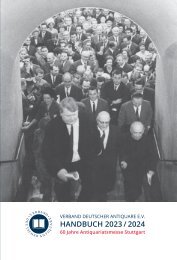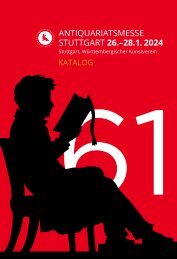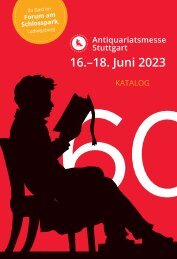Antiquariatsmesse Stuttgart 2021 - Katalog
Katalog zur Antiquariatsmesse Stuttgart 2021: Die Antiquariatsmesse Stuttgart als größtes Schaufenster für wertvolle Objekte des Antiquariats- und Graphikhandels in Deutschland findet in diesem Jahr in ungewohnter Form statt. Da eine Präsenzmesse nicht stattfinden kann, haben sich 76 Kollegen aus Deutschland, Großbritannien, Österreich, Frankreich, der Schweiz, den Niederlanden, den Vereinigten Staaten und aus Australien zusammengefunden, um einen Katalog für die Messe zu erstellen und gleichzeitig ein Angebot für eine virtuelle Messe zusammengetragen. Der Katalog wird am 7. Januar 2021 an interessierte Kunden verschickt, die virtuelle Messe öffnet ihre „digitalen Pforten“ am 29. Januar 2021 um 12.00 Uhr unter www.antiquariatsmesse-stuttgart.de
Katalog zur Antiquariatsmesse Stuttgart 2021: Die Antiquariatsmesse Stuttgart als größtes Schaufenster für wertvolle Objekte des Antiquariats- und Graphikhandels in Deutschland findet in diesem Jahr in ungewohnter Form statt. Da eine Präsenzmesse nicht stattfinden kann, haben sich 76 Kollegen aus Deutschland, Großbritannien, Österreich, Frankreich, der Schweiz, den Niederlanden, den Vereinigten Staaten und aus Australien zusammengefunden, um einen Katalog für die Messe zu erstellen und gleichzeitig ein Angebot für eine virtuelle Messe zusammengetragen.
Der Katalog wird am 7. Januar 2021 an interessierte Kunden verschickt, die virtuelle Messe öffnet ihre „digitalen Pforten“ am 29. Januar 2021 um 12.00 Uhr unter www.antiquariatsmesse-stuttgart.de
Sie wollen auch ein ePaper? Erhöhen Sie die Reichweite Ihrer Titel.
YUMPU macht aus Druck-PDFs automatisch weboptimierte ePaper, die Google liebt.
bookplate to front pastedown, and an early ms. note
of first flyleaf („proibito“ = forbidden). Ff. nn. 40,
collation: A–K4, last quire misbound, with ff. K1
and K4 inverted, printed italic type, woodcut initial
incorporating a portrait. € 3500,–
Very rare, undated edition of this poem (first edited in
Rome in 1526, this is possibly the second, the third was
printed in 1534, and no other afterwards in the 16th
cent.) by the Tuscan poet Francesco Berni, about the
card game „Primiera“, perhaps a forerunner of poker.
EDIT 16 records only three copies in Italian libraries,
KVK records apparently only one copy of the 1534
edn. in Germany, at the Staatsbibl. in Munich. EDIT
16 CNCE 5528; S. R. Kaplan, Encyclopaedia of Tarots,
New York 1978, I, pp. 28–29 (his copy). See about
this work Anne Reynolds, in La Bibliofilía. A. 98, n. 1
(1996), p. 31–43, Florence, Leo S. Olschki, 1996.
subject, with numerous references to characters from
mythology, the Iliad, the Aeneid and Roman history.
EDIT 16 records only two copies (in Florence, and in
the Vatican Libr.). In Germany is present only the 1518
edition. The woodcut border was first used by Bonelli
in his famous Aesop of 1491. Essling 1499 (mentioning
this copy, „Florence, Collection Torre, 1898“); Sander
6008; EDIT 16 CNCE 69334. – Siehe Abbildung.
Pulci, Luca. Epistole di Luca de Pulci al magnifico
Lorenzo de Medici. [Colophon:] Venice: Manfredo
Bonelli, 21 October, 1505. 8vo (146 × 94 mm.), 20th
cent. vellum over boards by Gozzi of Modena, gilt
covers with central fleuron bearing title and inscription
„Torre del Palasciano“. Gothic type, title
within a four-piece woodcut border, altogether 40
nn. leaves, collation: A–K4. € 5000,–
First edition, scarce, of this particular collection of
poems, a collection of letters in verse of imaginary
Hieroglyphs – Briga, Melchior dalla. Fascia Isiaca
statuae capitolinae nunc primum in lucem edita
Melchiore a Briga e Soc: Iesu interprete ad Ioannem
Baptistam Ptolemaeum S. R. E. cardinalem amplissimum.
Romae: Dominicus Franceschini, 1716.
Folio broadside (435 × 300 mm), single sheet, fully
engraved with text and illustration in a single copperplate
(350 × 270 mm). Small loss of a blank corner
at lower margin, early creasing. € 900,–
First and only edition. Melchior dalla Briga (S. J.,
1686–1749), a Jesuit and an Italian astronomer, published
in 1747 his „Scientia eclipsium“, which figures
a map of the moon that is particularly representative
of former cartographies that dominates selenography.
In this work, he helped Cardinal Gio. Battista Tolomei
(1653–1726) in the graphic representation of his interpretation
of some hieroglyphs, existing on a statue that
was in Rome in the capitol, matching it with a previous
interpretation given by Athanasius Kircher. Rare,
apparently no copy in Germany. OCLC 457144356;
IT\ICCU\RMLE\040878; Acta eruditorum, Vol. 41
(1722), p. 53. – Siehe Abbildung.
178






